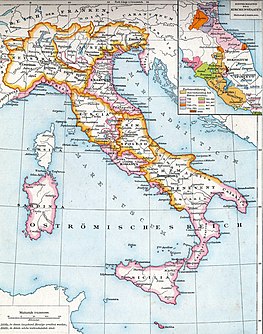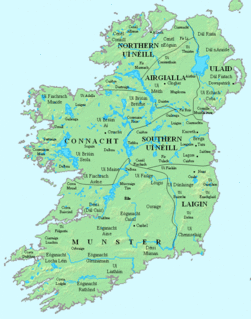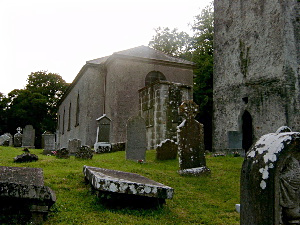
Ardbraccan is an ancient place of Christian worship in County Meath, Ireland. It is the location of the former residence of the Roman Catholic, then, after the Reformation, the Church of Ireland Bishop of Meath. It is located approximately 30 miles from Dublin.

The Rock of Cashel, also known as Cashel of the Kings and St. Patrick's Rock, is a historic site located at Cashel, County Tipperary, Ireland.
Loch Gabhair (Lagore), meaning "Lake of the Goats", is an area in the parish of Ratoath, County Meath, Ireland. It is located between the villages of Ratoath and Dunshaughlin and is the namesake of the townlands of Lagore Big and Lagore Little.

Dunsany Castle, Dunsany, County Meath, Ireland is a modernised Norman castle, started c. 1180 / 1181 by Hugh de Lacy, who also commissioned Killeen Castle, nearby, and the famous Trim Castle. It is possibly Ireland's oldest home in continuous occupation, having been held by the Cusack family and their descendants by marriage, the Plunketts, to the present day. The castle is surrounded by its demesne, the inner part of the formerly extensive Dunsany estate. The demesne holds an historic church, a working walled garden, a walled farm complex, an ice house, various dwellings and other features.
Saint Iserninus was an early Christian missionary of Ireland who is associated with Saint Patrick and Saint Auxilius in establishing Christianity in the south of that island. More recent research associates him not with Patrick but with Palladius.
Saint Auxilius, or Usaille, was an early Christian missionary of Ireland who is associated with Saint Patrick, Saint Seachnaill (Secundinus), and Saint Iserninus in establishing Christianity in the south of that island, although more recent studies tend to associate him with the earlier Palladius.
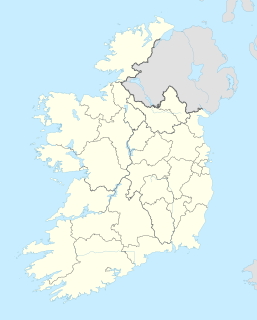
Mulhussey is a village in County Meath, Ireland. It has a school, a castle with accompanying cemetery, a nearby church at the edge of the Kilcloon parish in Kilcock, and a religious antiquity, St Bridgid's Well, located in Calgath, a townland near Mulhussey.
Events from the 5th century in Ireland.

Clanfield is a village and civil parish about three miles (5 km) south of Carterton, Oxfordshire. The parish includes the hamlet of Little Clanfield one mile (1.6 km) west of the village, on Little Clanfield Brook which forms the parish's western boundary. The parish's eastern boundary is Black Bourton Brook and its southern boundary is Radcot Cut, an artificial watercourse on the River Thames floodplain. The 2011 Census recorded the parish's population as 879.
Ratoath is a barony in County Meath. It comprises ten parishes and portion of two others viz Rathbeggan, Dunshaughlin, Kilbrew, Crickstown, Killegland, Cookstown, Donaghmore, Ratoath, and portions of Ballymaglasson and Trevit.
Aghade is a small civil parish, in the barony of Forth, County Carlow, Ireland. It is 3 miles from Tullow and has a notable bridge over the River Slaney. a church At one time it had a school.
Laraghbryan is the site of an old monastic settlement, cemetery and ruined church, 1 kilometre (0.62 mi) west of Maynooth, County Kildare, Ireland. It is the site of a graveyard which is in use by the Roman Catholic Parish of Maynooth. The ruined church consists of a nave and chancel with a tower attached, most of the ruined structure was part of a church built in Norman times, however this church was built on the site of a previous ecclesiastical settlement.
Saint Brecan was an Irish saint active in the 5th century AD. There are legends concerning Brecan from Clare and Aran, and wells and churches are dedicated to him in various places in Ireland. His main monument is the Tempull Breccain complex on Inishmore in the Aran Islands.

Cannistown Church is a medieval church and National Monument in County Meath, Ireland.

Killeen Church is a medieval church and National Monument in County Meath, Ireland.
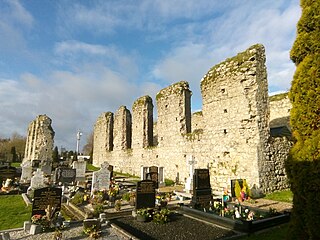
Clane Friary, also called Clane Abbey, is a former friary of the Order of Friars Minor Conventual located in Clane, Ireland.






